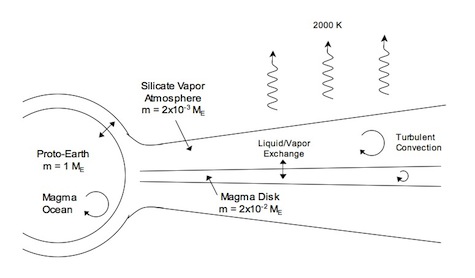|
Kaveh Pahlevan Planetary Scientist Home | Lunar Origin | Atmospheres | Tidal History | Publications | Contact | |
|
In the widely accepted giant impact hypothesis, the Earth-Moon system
originated from a collision between two planetary-sized bodies toward the
end of Earth accretion. Following such a collision, a circumplanetary disk
of molten and vaporized material surrounded the Earth from which the Moon
rapidly formed. Our understanding of what happened during this fluid stage of
the evolution is poor. The goal of my work here is to forge a connection
between the formation process and the lunar composition as observed in the
isotopes and chemistry of lunar samples. Earth-Moon equilibration Over the course of the past two decades, isotope geochemists have observed an increasingly precise match in isotopic abundances of oxygen [1], titanium [2], silicon [3], and tungsten [4] between rocks derived from Earth's mantle and Moon against a background isotopic heterogeneity among sampled Solar System bodies. The similarity is such as to leave little doubt that these two bodies are derived from the same reservoir [5]. But if the Moon is the result of a collision between two distinct planetary bodies, where is the isotopic evidence for the impacting planet? The scenario that I co-developed is that Earth's magma ocean and the proto-lunar magma disk underwent an episode of isotopic equilibration through exchange with a common vapor atmosphere in the energetic aftermath of the giant impact while the system existed in a fluid state [6]. | |
| |
|
Silicate Earth-Moon differences If turbulent mixing - or any other process - was responsible for deriving the lunar material from Earth's mantle, what then is the origin of the chemical differences between these two reservoirs? More recent work has focused on understanding the FeO enrichment of the lunar mantle [7], the presence of water in the lunar interior [8, 9], and the depletion of the proto-lunar disk in volatile elements due to hydrodynamic outflows [10]. A major new development is the measurement of stable isotopic differences between the silicate Earth and Moon [e.g., 11] and this is a topic of current study. | |
References
|
